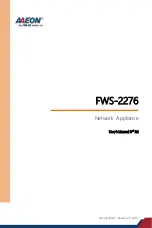
5-8
Cisco PIX Security Appliance Hardware Installation Guide
78-15170-03
Chapter 5 PIX 520
Installing LAN-Based Failover
Caution
Do not turn the power on until the units are connected and the primary unit is configured completely.
Step 7
Use the power switch at the back of the units to power the primary unit on and then power on the standby
unit.
Within a few seconds, the active unit automatically downloads its configuration to the standby unit.
If the primary unit fails, the secondary unit automatically becomes active.
Installing LAN-Based Failover
LAN-based failover supports failover between two units connected over a dedicated Ethernet interface.
LAN-based failover eliminates the need for a special Failover cable and overcomes the distance
limitations imposed by the Failover cable.
For information on configuring a LAN-based failover, refer to the
online at
:
http://www.cisco.com/en/US/products/sw/secursw/ps2120/prod_configuration_guides_list.html
Note
Both chassis must be the same model number, have the same amount of RAM, Flash memory, number
and type of interfaces, and be running the same software version.
To set up a LAN-based failover connection, perform the following steps:
Step 1
Disconnect both the PIX security appliances, so that there is no traffic flow between them. If the Failover
cable is connected to the PIX security appliance, disconnect it.
Step 2
Configure the PIX security appliances for LAN-based failover. Refer to the chapter on configuring
LAN-based failover in the
online at
:
http://www.cisco.com/en/US/products/sw/secursw/ps2120/prod_configuration_guides_list.html
Step 3
Power off both units.
Step 4
Connect the LAN failover interfaces to the dedicated switch/hub, as shown in
.
Note
A dedicated LAN interface and a dedicated switch (or VLAN) is required to implement
LAN-based failover. You cannot use a crossover Ethernet cable to connect the two PIX security
appliances.
















































